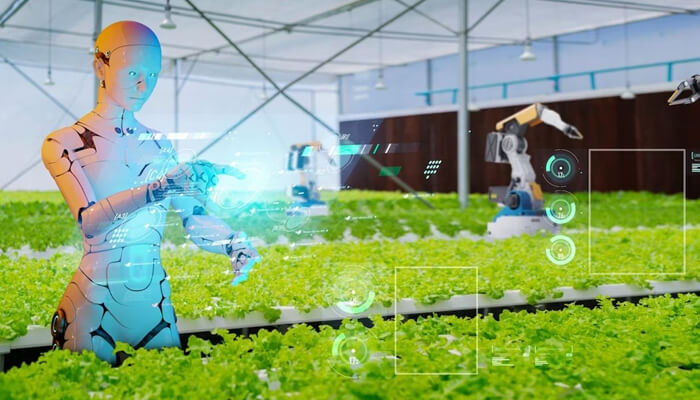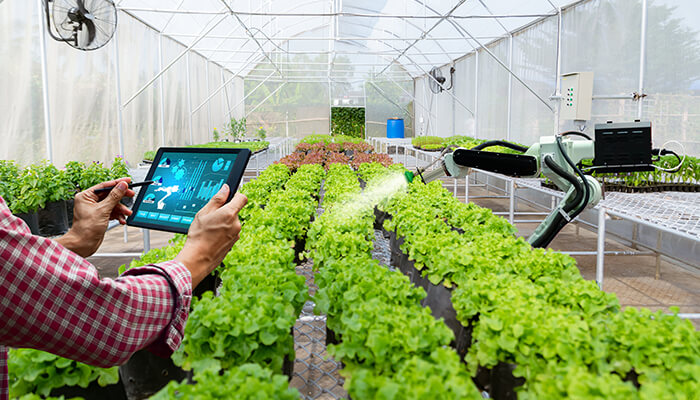AI in Agriculture systems work to improve the harvest quality overall. It is to promote the agriculture sector to precision. AI technology helps detect disease in pests, plants, and farms with poor nutrition. The sensors of AI (Artificial Intelligence) target and detect weeds.
Different Ways AI Has the Potential to Improve Agriculture in the Upcoming Days
1. Agricultural worker shortage is making AI learning a viable option for remote agricultural operations. Large-scale agricultural businesses are unable to get enough employees on hire. The potential to improve agriculture relies largely on self-propelled robotics distributing fertilizer on the crops. It improves field yields while the operating costs are low.
2. Machine learning and AI improve the prediction of crop yield using drones to get visual analytics data and real-time sensors. The smart sensors capture data, and the drones give video streaming in real time. It also combines moisture, a natural nutrient, and fertilizer to analyze crop growth patterns. Using technology and combining massive sets of data assures new insights to improve crop yields and healthy lifestyles.
3. Monitoring in real-time the crops in the field is now possible with machine learning and AI systems. It also identifies human or animal breaches, thus destroying crops or breaking remote. The AI systems send an alert to protect the field immediately. The video surveillance systems are suitable for individual and large-scale agriculture sector operations. It proves effective in optimizing crops and preventing trespassers.
4. Pest management is the biggest benefit in agricultural operations. The drone data, in combination with sensors in-ground, improve pest management using an autonomous sprayer. AI identifies pest infestations and predicts them before it occur. The drone’s infrared camera data ensures a proper ground to work in conjunction.
5. Another technique is yield mapping. It finds patterns in large-scale data and supervises algorithms of machine learning. It helps understand the potential yield rates before the start of a vegetation cycle. The 3D mapping, soil color data, and social condition data predict soil yield potential for any crop.
6. Forecasting on yield rates for crops helps in predicting total production in values and in deciding the price strategies. Understanding yield rates and agricultural farms’ crop quality levels helps negotiate the harvest price and enjoy a healthy lifestyle. The demand for crops determines the elasticity curve for a crop and arrives at the pricing strategy.
7. The biodegradable pesticides in the right mix limit application. Thus the cost is reduced as it is applicable only to essential areas. The intelligent sensors with visual data from drones detect the highly infected planting area. Using the algorithm of supervised machine learning, defining the pesticide optimal mix helps reduce the threat of pests from spreading further.
8. Optimizing irrigation systems and checking the frequent crop effects means improving irrigation yield rates. AI learning improves the efficiencies of farming. Even in areas facing water scarcity with agriculture as the main business, AI makes a difference in an agricultural operation. It calculates the water amount for a crop or a given field to yield. Such algorithms of supervised machine learning ensure the crops and fields receive enough water. There is no wastage, and the yields are the best.
9. Agriculture sector supply chain tracking improves by eliminating roadblocks. The tracking and traceability feature reduces inventory shrinkage in the supply chains. Track and trace advanced systems are becoming common in manufacturing places because of the IoT and RFID sensors. It is because of the efficiency.
10. Livestock health monitoring allows for taking care of their food intake, daily activity, and other signs. Machine learning and AI machines understand the reaction of livestock to diet and give the best treatment. They use an autonomous sprayer if required. Farmers relying on livestock and cows are open to this new insight that keeps their livestock happy and healthy, producing more milk and making farms profitable.



